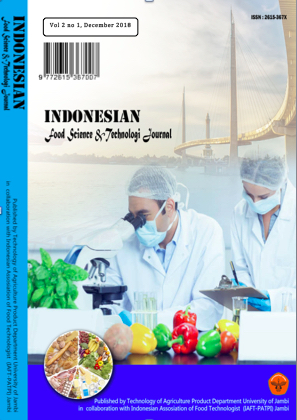The Effects of Frying Time and Temperatures on Fatty Acids Profile of Blanched Potato Chips
DOI:
https://doi.org/10.22437/ifstj.v2i1.7268Abstract
The aim of this research was to study whether the frying time and temperature affected fatty acids profiles of blanched potato chips. Factorial designs were carried out using a completely randomized design (CRD) two factor (time and temperature) and three levels with two replications. Frying temperature was set up at 160 0C, 180 0C and 200 0C. The potato chips were fried for 3, 5, 7 minutes. The oil type used was sunflower. The fatty acids profiles were analyses with capillary gas liquid chromatography (Varian 3400) equipped with an auto sampler and a flame ionization detector (FID) using a 50 m x 0.32 mm (I.D) fused silica bonded phase capillary column (BPX70, SGE, Melbourne, Australia). The experiments were run in duplicate and the present results are the average of the obtained values. ANOVA analysis of the results was carried out using SPSS software (version 11, 2004). The key plot software for making three dimensions was the sigma plot scientific graphing software.
The results showed moisture content and colour index of blanched potato chips decreased significantly with increasing frying time and temperature. Furthermore, unsaturated fatty acids (cis oleic and linoleic) decrease after long period frying.
Downloads
References
[2] Mehta, U., & Swinburn, B. (2001). A review of factors a.ecting fat absorption in hot chips. Critical Reviews in Food Science and Nutrition, 41(2), 133–154
[3] Camire, M. E., Kubow, S., & Donnelly, D. J. (2009). Potatoes and human health. Critical Reviews in Food Science and Nutrition, 49, 823–840. http://dx.doi.org/10.1080/ 10408390903041996.
[4] Decker, E. A., & Ferruzzi, M. G. (2013). Innovations in food chemistry and processing to enhance the nutrient profile of the white potato in all forms. Advances in Nutrition, 4, 345S–350S. http://dx.doi.org/10.3945/an.112.003574.
[5] Gillingham, L. G., Harris-Janz, S., & Jones, P. J. H. (2011). Dietary monounsaturated fatty acids are protective against metabolic syndrome and cardiovascular disease risk factors. Lipids, 46(3), 209–228. http://dx.doi.org/10.1007/s11745-010-3524-y.
[7] Melton, S.L., S. Jafar, D. Sykes and M. K. Tigriano. 1994. Review of stability measurements for frying oils and fried food flavor. J. Am. Oil Chem. Soc. 71, 1301- 1308.
[8] Moreira, R. G., Sun, X., & Chen, Y. (1997). Factors affecting oil uptake in tortilla chips in deep fat frying. Journal of Food Engineering, 31(4), 485–498.
[9] Arroyo, R., Cuesta, C., Garrido-Polonio, G., López-Varela, S., & Sάnchez-Muniz, F. J. (1992). High-performance size-exclusion chromatographic studies on polar components formed in sunflower oil used for frying. Journal of the American Oil Chemists’ Society, 69(6), 557–563.
[10] Wang, S.-N., Sui, X.-N., Wang, Z.-J., Qi, B.-K., Jiang, L.-Z., Li, Y., & Wei, X. (2016). Improvement in thermal stability of soybean oil by blending with camellia oil during deep fat frying. European Journal of Lipid Science and Technology, 118(4), 524–531.
Downloads
Published
Versions
- 2018-12-20 (1)
- 2018-12-20 (1)








